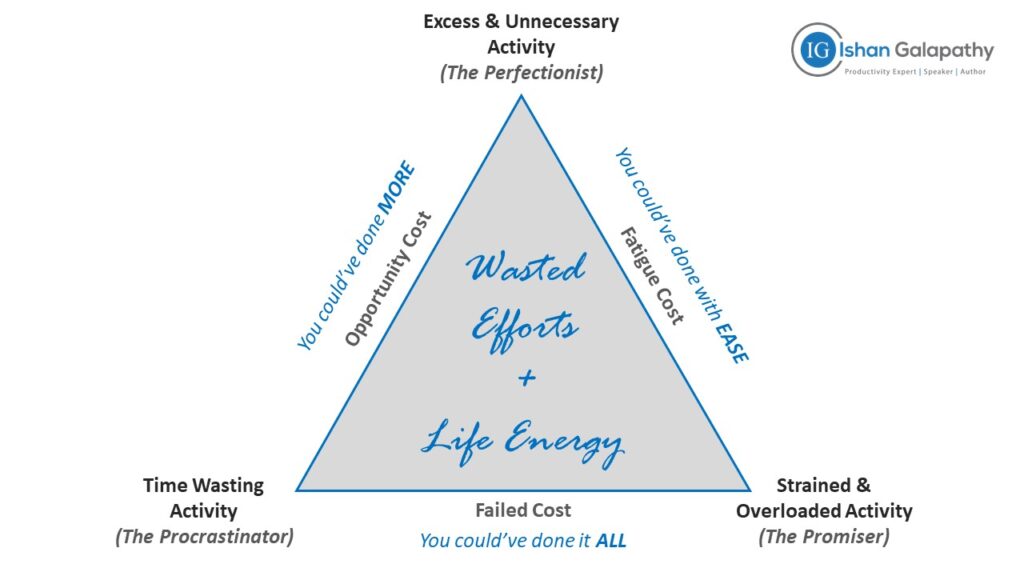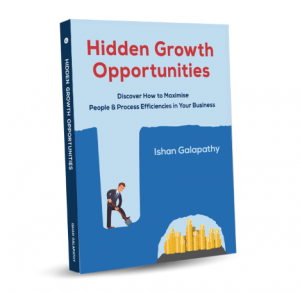In my previous newsletter I shared the overarching ‘universal’ framework to improve productivity and performance, at work or home; 1) Identify, 2) Prioritise and 3) Implement.
Over the coming weeks I intend to go deeper into each one of these areas. So, let’s focus on Identifying improvement opportunities today.
(If you’d rather watch the recorded session from last week instead of reading, then click here. I’ve time stamped it 16:45min which is where the content begins – you’re welcome)
At the core of identifying improvement opportunities is the notion of exploring areas where we waste our efforts and energy. In business, we look for wasted opportunities that could either deliver a higher profitability or capacity to grow. In life, I believe we have a fixed amount of energy that I’ve defined as ‘Life Energy’, which is a combination of the number of years we’ve been given on this planet multiplied by the energy we have to get things done at any given moment. Therefore, we have a fixed and limited quantity Life Energy units, and the game is to get things done in an effective and efficient way so that we don’t burn these Life Energy units in a wasteful manner.
The simplified framework below provides three lenses to identify where we lose efficiency and effectiveness – this works for both home and busines

Time wasting activity – we all get this. We know where we could have effectively used our time whether it is the wasted Saturday morning, time on Netflix or YouTube, we all feel guilty in retrospect. These are the obvious ones. But, if you dig deeper there are hidden activities that are camouflaged as being productive – for example, waiting in queues, waiting for another person to get ready, going up & down stairs multiple times to get ready and the biggest opportunity – looking for misplaced items (why do teenage children never put the tools back into the toolbox??). Given that the majority of these tasks are either just waiting in idle or waiting to implement a better system, you will agree with me that it is the procrastinator in us that drives these behaviours.
Excess and unnecessary activity – think about the time we spend on perfecting documents, diagrams, formatting etc. These are tasks where we are polishing the diamond. You know these tasks have diminishing returns delivering very little value. I’ve recently discovered that it is much faster to dictate on Microsoft Word than to type. In fact, this very newsletter was created using this feature. Typing for me is now an unnecessary activity for certain things in my practice. The perfectionist in us can help to identify these tasks.
Strained an overloaded activity – we all take on too much at times than the capacity to deliver. And in doing so we burden ourselves in trying to deliver under unrealistic time constraints. These are the strained activities that overload our schedule. Have you ever been to a supermarket only to buy a handful of items and ended up carrying an overloaded basket with difficulty? You burn more Life Energy trying to navigate through the supermarket aisles with a lopsided weight on one shoulder and burning more energy in trying to ensure that you don’t bump into other people. It is the promiser in us that takes on more tasks by saying yes because we want to do more or don’t want to say no to others. The business strategist guru Peter Drucker once said, ‘the key to strategy is not inclusion but omission’. What you say no to is more important than what do you say yes to.
Let’s explore what’s happening between these wasted activities in our framework – the space between the three corners of the triangle in our framework. Between time wasting activity and unnecessary activity, we waste Life Energy where we could have spent it more effectively. This is the wasted opportunity cost where we could have done MORE.
Between excess activity and overloaded activity, we burn unnecessary Life Energy by being frustrated working under strained conditions. And perhaps working on tasks that could have been avoided all together. The outcome is the fatigue cost. Had we paid a little bit more attention to this, we could have done these activities with EASE.
Finally, with wasted time coupled with overloaded activity we know that something has got to give. We all know what it is like when we have to make those the last-minute apology calls, just-in-time has become just-too-late, and the feeling that you could have done it ALL. Instead, the outcome is the failed cost of Life Energy.
By identifying wasted Life Energy by looking through these three lenses and carefully eliminating them, will help you to get all plus more done with ease.





